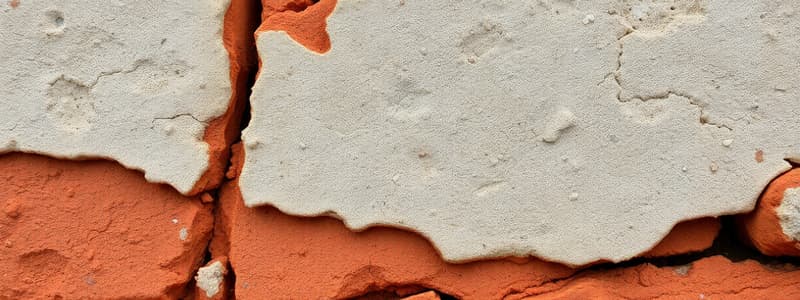Podcast
Questions and Answers
Explain how the process of freeze-thaw weathering contributes to the formation of distinctive landforms, such as talus slopes and scree.
Explain how the process of freeze-thaw weathering contributes to the formation of distinctive landforms, such as talus slopes and scree.
Freeze-thaw weathering, also known as frost wedging, occurs when water seeps into cracks in rocks and freezes. As water freezes, it expands, putting pressure on the rock. This repeated freezing and thawing cycle causes the cracks to widen and eventually break the rock into smaller fragments. These fragments, known as scree or talus, accumulate at the base of slopes, forming distinctive talus slopes. The accumulation of these fragments creates a characteristic loose, angular, and often steep slope, which is a key feature of mountainous and periglacial landscapes.
Describe the role of biological weathering in soil formation, highlighting the specific mechanisms employed by organisms like plants, lichens, and burrowing animals.
Describe the role of biological weathering in soil formation, highlighting the specific mechanisms employed by organisms like plants, lichens, and burrowing animals.
Biological weathering involves the breakdown of rocks through the actions of living organisms. Plants exert pressure on rocks as their roots grow, causing cracks to widen. Lichens produce acids that chemically break down rocks, releasing minerals and creating a substrate for other organisms. Burrowing animals, like earthworms and moles, have a significant impact by churning soil and exposing rock fragments to further weathering. Their activities also contribute to nutrient cycling and improve soil aeration, ultimately promoting soil formation.
Explain how differential weathering can create unique and often dramatic landscapes, providing examples of landforms resulting from this process.
Explain how differential weathering can create unique and often dramatic landscapes, providing examples of landforms resulting from this process.
Differential weathering occurs when different rocks or rock layers weather at varying rates due to variations in their composition, texture, and hardness. This leads to the formation of distinctive landforms. For example, soft sedimentary rocks, such as sandstone, weather more rapidly than harder igneous rocks, like granite. This can result in the formation of cliffs, arches, and buttes, as the softer rocks erode away faster, leaving the harder rocks standing. Another example is exfoliation domes, where layers of granite peel away due to variations in weathering rates between the surface and the interior.
Discuss the impact of weathering on the formation of caves and karst landscapes, focusing on the role of chemical weathering and dissolution.
Discuss the impact of weathering on the formation of caves and karst landscapes, focusing on the role of chemical weathering and dissolution.
Explain how weathering contributes to the overall process of erosion, highlighting the connection between these processes.
Explain how weathering contributes to the overall process of erosion, highlighting the connection between these processes.
Flashcards
Weathering
Weathering
The breakdown of rocks into smaller pieces by natural forces.
Mechanical Weathering
Mechanical Weathering
The physical breakdown of rocks without changing their composition.
Chemical Weathering
Chemical Weathering
The process that alters the minerals in rocks through chemical reactions.
Biological Weathering
Biological Weathering
Signup and view all the flashcards
Erosion
Erosion
Signup and view all the flashcards
Study Notes
Introduction to Weathering
- Weathering is the process by which rocks are broken down into smaller pieces, or sediments, through physical and/or chemical processes.
- These processes do not involve the movement of the weathered material.
- Weathering occurs in situ, meaning it takes place where the rock is located.
- Weathering can be a slow, incremental process or occur rapidly.
- Weathering plays a crucial role in the rock cycle.
Types of Weathering
- Weathering can be categorized into two main types: physical and chemical.
Physical Weathering
- Physical weathering involves the disintegration of rocks into smaller pieces without any change in their chemical composition.
- Common physical weathering processes include:
- Frost wedging: Water expands when it freezes, exerting pressure on rock fractures, causing them to widen and eventually break apart.
- Thermal expansion and contraction: Repeated heating and cooling of rocks can cause them to expand and contract, leading to stress and cracking.
- Exfoliation: Pressure release due to the uplift and erosion of overlying rock layers causes the outer layers of rock to peel off.
- Abrasion: Rocks and sediments grinding against each other during transport by wind, water, or ice can break down the rocks involved.
- Biological activity: Plant roots growing into cracks in rocks, exerting pressure as they grow, can cause rocks to break apart.
Chemical Weathering
- Chemical weathering involves the breakdown of rocks through chemical reactions with the environment.
- Common chemical weathering processes include:
- Oxidation: Reaction of minerals with oxygen, forming oxides.
- Hydrolysis: Water reacting with minerals, often leading to the formation of new minerals.
- Carbonation: Reaction of minerals with dissolved carbon dioxide, forming carbonates.
- Dissolution: Minerals dissolving in water.
- Chemical weathering rates are influenced by factors like temperature, moisture, and mineral composition.
Factors Affecting Weathering
- Climate: Temperature and moisture are key factors influencing both physical and chemical weathering.
- Warmer temperatures generally increase the rate of chemical weathering.
- Higher precipitation levels enhance the availability of water for chemical reactions.
- Rock Composition: Different minerals have varying resistance to weathering.
- Minerals like quartz are highly resistant to chemical weathering, while minerals like feldspar are more susceptible.
- Topography: Slope and exposure to sunlight and wind can influence the rate and type of weathering.
- Steeper slopes are often more susceptible to physical weathering.
- Exposure to wind may speed up abrasion.
Importance of Weathering
- Weathering is a fundamental process in shaping landscapes.
- It produces sediment for transportation, erosion, and deposition.
- It helps create soils, essential for plant growth.
- It contributes significantly to the rock cycle, altering rocks and minerals over time.
- Understanding weathering processes is crucial for various environmental and geologic applications.
Studying That Suits You
Use AI to generate personalized quizzes and flashcards to suit your learning preferences.




